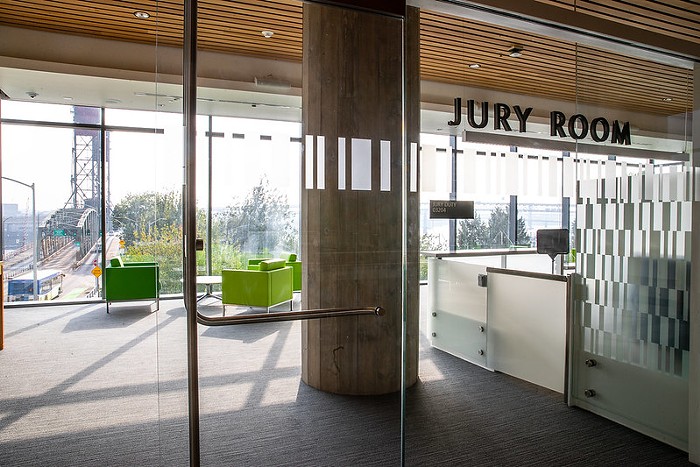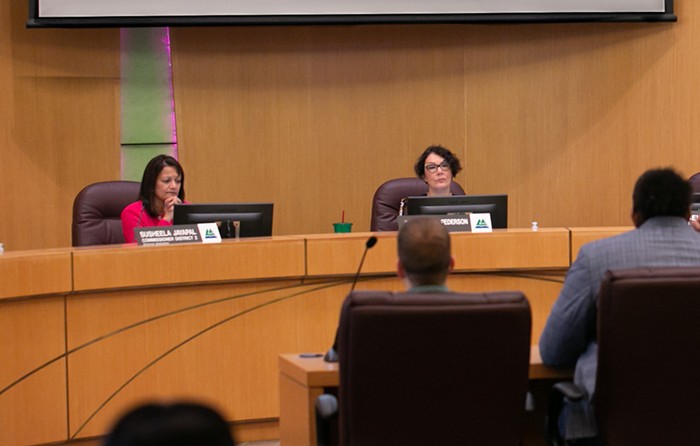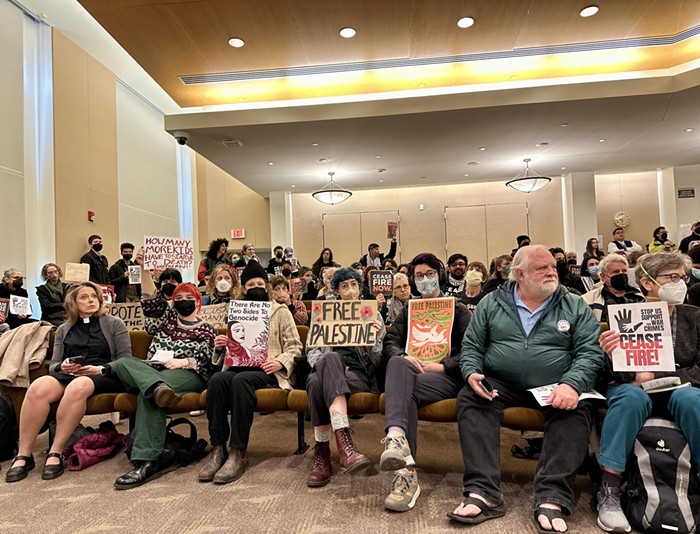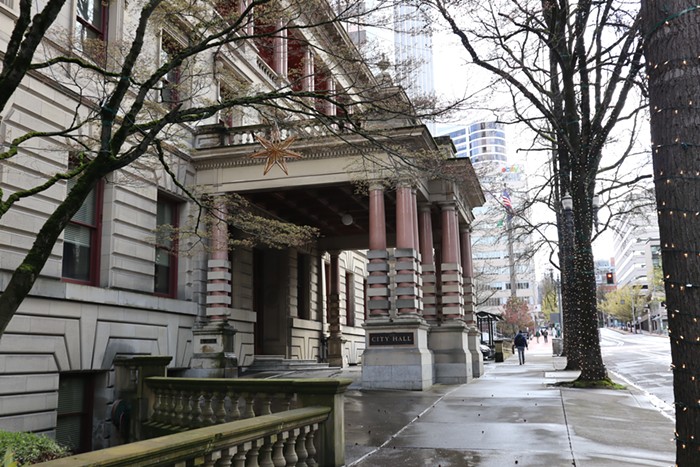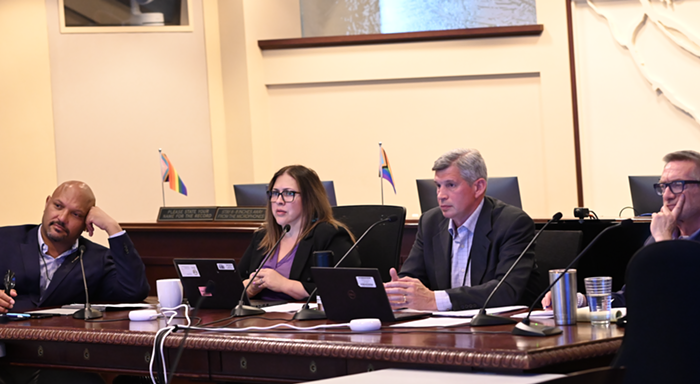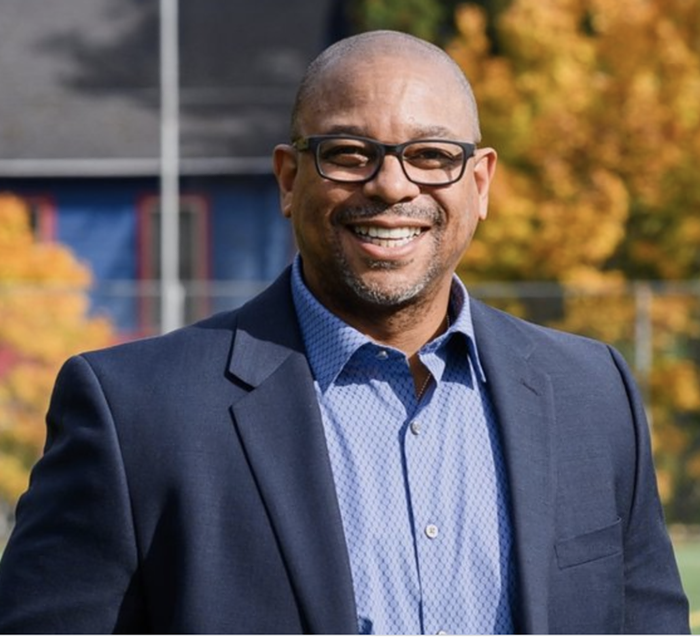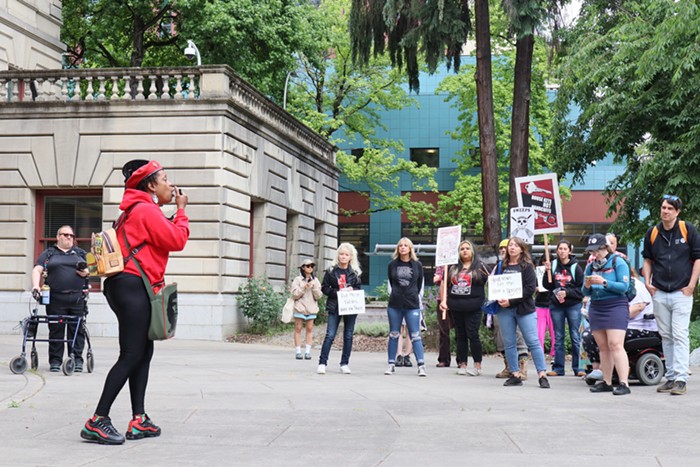MONDAY
“You don’t have to justify what you’re doing.”
On Monday morning, the Northwest Abortion Access Fund’s weekly budget is replenished, and a new hotline shift begins.
This week, Jeanie Schauerman is one of two volunteers staffing the hotline, responding to callers throughout the Pacific Northwest who need help paying for their abortion procedures. Schauerman’s been doing this work for 12 years, and her shift always starts the same way: She gets up on Monday morning, makes some coffee, and checks her phone to see what funding requests have come in since the previous shift ended on Friday. Then she corrals her pets, finds a quiet spot in her home, and starts returning calls.
Schauerman is warm and opinionated in the way of old-school reproductive rights activists—the ones who remember life before Roe v. Wade legalized abortion in the United States. In an email sent after our initial conversation, she discloses that she lost a friend to a back-alley abortion in the days before Roe: “Never again!”
Schauerman says she initially wanted to be a clinic escort—a volunteer who helps patients get past the anti-abortion protesters who frequently throng clinic entrances—but found it didn’t jibe with her work schedule. So instead, on the suggestion of an activist friend, she started working at the abortion fund hotline. She’s been answering the phone ever since. Monday and Tuesday are her busiest days.
“The first week I was on the hotline, 12 years ago, I almost quit because I had so many calls that first day, and I thought, ‘I just can’t do this and work full-time. I just can’t do this,’” says Schauerman. “And then it tapers off.”
This week she had backup. Until Monday, November 6, Schauerman had been volunteering with the Network for Reproductive Options (NRO), an Oregon-based fund. But this week was the first in a merge between NRO and the CAIR Project, a Washington State abortion fund. The newly formed Northwest Abortion Access Fund (NWAAF) provides abortion funding to the largest service area in the nation, one that spans Oregon, Washington, Idaho, and Alaska, effectively making it the biggest such fund in the country. “I like to say it’s a million square miles geographically, but it’s also a million square miles culturally,” says NWAAF Board President Katherine McGuiness.
Case in point: After NWAAF’s first week in existence, Schauerman reported that most of her calls came from Idaho.
“That’s crazy,” I say.
“Well, that’s sad,” she replies. “Because they have nothing in Idaho.”
According to NWAAF advocates based in both Oregon and Washington, it’s also typical. Throughout the country, anti-abortion activists have pushed model legislation on statehouses in a coordinated effort to make abortion a right in name only—it’s death by a thousand cuts, in the form of disingenuous, medically unsound restrictions that include mandatory waiting periods, parental notification laws, and targeted regulation of abortion provider (TRAP) laws. These include things like holding abortion clinics to the same physical standards as ambulatory surgical centers, or forcing mandatory junk-science scripts on doctors as a way to propagate long-debunked myths about abortion.
Because NWAAF’s service region spans a patchwork of varied abortion laws and provider availability, the need for funding is demonstrably greater in certain areas.
Oregon and Washington don’t have any TRAP laws on the books, and while the Hyde Amendment—the federal budget rider passed by Congress every year—denies federal coverage of abortion, both Oregon and Washington’s state Medicaid funds cover abortion procedures, through the Oregon Health Plan (OHP) and Washington Apple Health.
In Idaho, that safety net doesn’t exist.
The state has a parental notification law and a 24-hour waiting period, which can make seeking care burdensome and expensive. According to the Guttmacher Institute, a pro-choice research organization, from 2011-12, the average cost of a surgical abortion procedure at 10 weeks’ gestation with local anaesthesia was $480; the average cost of a chemical abortion, which is induced with medication rather than a procedure, was $504. And beyond the first trimester, the cost of an abortion goes up incrementally: The average cost of a procedure at 20 weeks is $1,500.
Because Idaho doesn’t have statewide paid sick leave, NWAAF’s McGuiness says women seeking abortions there may have to take uncompensated time off for their appointments. And if they’re among the 59 percent of women seeking abortions who have already had at least one child, they have to line up childcare, too.
To complicate matters further, says McGuiness, “There are four clinics in Idaho, and three are in one city—so really, there’s two places where you can get an abortion in Idaho. So the amount of travel that incurs, the lack of public transit systems... I mean, these abortion restrictions also play into other barriers that folks face when needing an abortion.”
A conversation with Carly* confirms this. Carly is a student in her 30s who lives in Idaho and received funding from the CAIR Project to help cover the out-of-pocket cost of an abortion procedure. In addition to a combination of funding from CAIR and a friend who was willing to share a flexible spending account insurance card, Carly says the fact that she happens to live near one of those four clinics was instrumental in her ability to access care.
Carly grew up attending Christian schools and regularly attends church with her family. “I don’t like that I had to make that decision,” she says of her choice to have an abortion. But it was the right thing for her family: She has three children, and her previous pregnancies were medically complicated both for her and her children. She needed to consider what was best for them. “I know deep down in my heart that it wouldn’t be fair to that child,” she says. “It wouldn’t be fair to my kids.... Having children is not just a thing you do. It’s a huge decision.”
Carly had her abortion when she was only five weeks pregnant. But she tells me that because Idaho has no second-trimester abortion providers, women who find out they’re pregnant later than she did often end up needing to travel to Oregon or Washington for care. For those cases, NWAAF also operates a practical support program to help to cover non-medical expenses related to abortion, like transportation and places to stay.
Carly has insurance coverage through Medicaid, but because Idaho is an abortion-hostile state without a local Medicaid option for covering the procedure, she had to pay for her abortion out of pocket.
“It’s crazy that [the state] wouldn’t cover a $600 choice, but would cover medical insurance for that child for the next 18 years,” she says.
But even when state Medicaid funds cover abortion, and even when women have private insurance, access can still be a problem.
“Sometimes people end up having to pay for their entire abortion out of pocket anyway, even though they have insurance they pay for, or that they get through an employer-sponsored plan, because the deductible is just too high. So effectively they don’t have coverage,” says Samantha Gladu, Board Vice President of NWAAF.
Women may also have to pay out-of-pocket if they’re on federal insurance plans, which the Hyde Amendment prevents from covering abortion. This includes women in the Peace Corps, Native American women whose insurance comes from the Indian Health Service, and military servicewomen on TriCare insurance through the armed forces. None of these programs cover abortion. For Alisha, a woman in the military who had to travel to Oregon from out of state for her procedure, that meant her abortion at 15 weeks cost $2,000. Even with funding from what was then NRO, Alisha is still paying off the portion of her abortion that she paid for herself, months after her appointment.
These gaps in coverage, along with confidentiality concerns and the artificial, politically-motivated separation of reproductive health care from other forms of health care, advocates say, creates a stark situation for women seeking abortions. It also means patients often need to show up to their appointments with the full cost of their procedure on hand, either in the form of cash or promised vouchers.
Then there’s the problem of the federal government’s reversal of Obama-era protections for birth control. Improved access to birth control has been shown to reduce abortion rates. It doesn’t take an expert to deduce what the consequences of its opposite will be.
All of this means that by the time women reach the hotline, they’ve often already exhausted most other options. At that point, says Schauerman, the callers she speaks with sometimes just need to talk: “So I let them talk.”
And if they’re apologetic about their decision to have an abortion, says Schauerman, “I always tell them, ‘You don’t have to justify what you’re doing, to me. Please, it’s your decision—I support you 100 percent in whatever you decide to do.’ I think it’s important for them to know they’re not being judged, and I feel really, really bad when somebody starts to feel like they have to say, you know, ‘My birth control didn’t work’ or ‘I didn’t use it’—it’s none of my business. I’m there just to support them in whatever decision they make.”
*Some hotline callers’ names and identifying details have been changed to protect their privacy.TUESDAY-WEDNESDAY
“I think we have to know that when we can’t fully fund people... that person might not get the abortion they need.”
I interviewed five hotline advocates from Oregon and Washington for this article. All of them reported that often, funding on the hotline runs out by Tuesday or Wednesday.
There’s a good reason for this.
“You know, for the most part, the structure that [we] operate under is that we will fund within the given week of a procedure appointment,” says Ellie Witwer, NWAAF’s hotline manager. “And that’s just because we want to make sure we’re prioritizing people who are scheduled within that week... the upcoming appointment that’s scheduled for tomorrow rather than two weeks away.”
When someone is turned down for funding, they’re typically told to reschedule their appointment and call back the following week.
“At the same time, we don’t drop people,” says Patricia Atwater, who operates NWAAF’s practical support program. “If people are okay with rescheduling and working with us, we’ll make sure people get seen.”
Still, says Schauerman, “If you just don’t have $550 for a procedure, you just don’t have it. And you have to pay rent, you have to [buy] food, you have to take care of your children if you have other children, and the idea of trying to scrape together $550 or $700 or even $200 can just be totally overwhelming.”
Schauerman says that telling someone she can’t fund her procedure is one of the worst parts of working the hotline. “It’s really hard when you have to tell someone, 'I’m out of funds this week.’ That’s got to be the hardest thing for me,” she says. “I really have a tough time with that. I wish we could just give it to everybody. I just think that abortion should be free anyway, but that’s my biased opinion.”
A friend of mine who has experience volunteering on an abortion fund hotline once told me that when she couldn’t fund someone, she told herself that she just had to trust that the person on the phone would be resourceful enough to figure out funding for themselves. I ask McGuiness if she ever does this.
“I tell myself that too,” she replies. “But I also know that’s not necessarily true. I think we have to know that when we can’t fully fund people to what they need—whether that’s funding their whole abortion, or if they need $300 and we can only do $200—there’s an absolute good chance that person might not get the abortion they need.”
And what happens then?
“Self-induced abortion,” says McGuiness, with hardly a pause.
“Increased risk of poverty,” says Gladu.
“Getting into a cycle of not being the person to steer your own life, because suddenly you’re making decisions about your life based on an unintended pregnancy,” adds McGuiness.
They’re right. The link between being denied an abortion and heightened risk of poverty is well documented. In 2013, the New York Times reported on a study conducted by University of California-San Francisco Associate Professor of Obstetrics & Gynecology Diana Greene Foster, which found women who were denied abortions were three times as likely as those who had abortions to end up living below the federal poverty line two years later. Women denied abortions also reported more negative health outcomes.
As for the specter of self-induced abortion, while it might seem a macabre relic of pre-Roe America, the risk is real, and the consequences are horrific. When abortion clinics were shuttered in Texas following the 2013 passage of restrictive TRAP law House Bill 2 (HB2), the Texas Policy Evaluation Project estimated that between 100,000 and 240,000 women attempted to self-induce abortions. The outcomes of self-induced abortion are also well established: They include infection, sepsis, and death.
McGuiness says she also worries about the women the hotline doesn’t hear from. “Folks who need abortion funds are often the most resilient and resourceful folks already,” she says. “I mean, they’re at a point where they’re calling someone they don’t know, so I’m often less worried about the folks that will call us, because they’re at a place where they feel confident enough to reach out to someone who’s a stranger. I’m worried about the folks that don’t call us. So are those the folks that just don’t get an abortion? Because it takes a certain amount of confidence to call someone you don’t know, and be vulnerable with them and explain your situation. There’s also a cultural aspect to that, around who feels like they deserve help and who feels like they don’t. And so I worry about the folks that don’t call us—who hear the price when an abortion clinic says the amount, and hang up, and then just continue with their pregnancies.”
THURSDAY-FRIDAY
“Can anybody help out this week?”
On Thursday and Friday, says Schauerman, calls to the hotline usually slow down. The end of the week is dedicated to making sure everyone who’s able to be funded is covered, and getting back to callers who’ve left messages.
Most abortion funds are staffed by volunteers. They are, by nature, scrappy activist organizations, and NWAAF is no different. Though there’s a sense among the NWAAF volunteers I spoke to that more money is always needed, it’s also clear that the organization has come a long way since, as Schauerman describes it, “back in the day when we used to have just a little flip phone that we shared back-and-forth.” The hotline really did travel—it was passed off between between volunteers living in Portland and Eugene. It even went on vacation with Schauerman. Volunteers now use an app, but in NRO’s early days, hotline volunteers passed around that little phone, and carried notes over from shift to shift in a notebook.
This grassroots approach also means that the staffers I talk to are more forthcoming than their counterparts at more well-known abortion rights organizations. While a request for comment from Planned Parenthood might result in a carefully crafted media release by press time, the volunteer staff of NWAAF return my calls and emails promptly. They schedule conference calls and come into the Mercury offices for interviews. One woman who received abortion funding from NWAAF talks to me for nearly an hour over the phone.
They also don’t couch what they do in euphemistic, empty phrases like “women’s health.” When the CAIR Project and NRO merged, they intentionally included the word “abortion” in their new name.
“We had previously not had ‘abortion’ in either of our names,” says McGuiness of the decision, “and we’re not ashamed to be an abortion fund and, really, we weren’t the Network for Reproductive Options, because we weren’t going to help someone pay for their hysterectomy... I mean, we hadn’t. Maybe we would. But we weren’t able to pay for people’s colposcopies, or other reproductive services, and we weren’t paying for birth charges. We weren’t doing any of that. And so we were at a place where we didn’t want to dance around it anymore. I understand that to be able to not dance around that is a real privilege, and it’s a privilege that we have that a lot of our colleagues in Southern states don’t have. They’re targets of hate and violence if they use that word—and so, because we can say it, we should say it, and we should be really loud about it.”
“Abortion is normal,” adds Gladu. “It happens! There’s no getting around it.... Everybody knows someone who’s had an abortion, because one in three women do have an abortion. So, chances are, if you haven’t heard about it, you just haven’t asked.”
The fund’s approach to reproductive rights is also representative of a more inclusive version of feminism than the cautious white feminism the pro-choice movement has often been criticized for in the past. It also represents the voice of a younger generation than the one that marched in support of Roe. NWAAF’s website contains overt references to intersectional feminism, the Black Lives Matter movement, and reproductive justice—the human rights paradigm pioneered by women of color that hinges on the idea that reproductive rights fit into a larger vision of social justice that includes racial and economic equality. It’s not just a matter of good optics, either: NWAAF has bilingual hotline staffing and an extra source of funding available for Spanish speakers, set up in part as a way of recognizing that non-native English speakers often face an additional barrier to health care. (I often hear women in their 60s and 70s opine that there are no young reproductive rights activists; I have to wonder if they know about abortion funds.)
NWAAF is one of 70 grassroots funds nationwide that are part of a network called the National Network of Abortion Funds (NNAF). Sometimes, NWAAF gets calls from women far out of state—Schauerman says many came from Texas after clinics began closing in 2013 due to HB2. When that happens, NWAAF staff refer callers to their own local funds.
And though NWAAF obviously doesn’t have anywhere near the resources that more visible reproductive rights organizations do, they seem a lot more fun. There are no political galas on NWAAF’s social calendar. Instead, they fundraise with a yearly bowl-a-thon and off-the-cuff fundraising initiatives like NNAF’s “taco or beer challenge,” which specifies only that participants must “eat a taco and/or drink a beer” and make a donation to an abortion fund. McGuiness has made freezer jam as an impromptu fundraiser for NRO. When funding hits a wall, volunteers often turn to their counterparts across the country via a private Facebook group.
“Often times, within the abortion fund network, we’ll see Facebook posts saying, ‘Hey, I’m working on this caller... the cost is $25,000. We have $13,000. Can anybody help out this week?’” says Gladu.
“You see people throw in whatever they can, from $50 to $500,” says McGuiness.
MONDAY
“People’s dignity is at the heart of this.”
Unless something drastically changes, this will be the reality for women in the Pacific Northwest and across the country: If they can’t afford an abortion, they will need to call someone they don’t know, at a phone number they don’t recognize, to ask for help—all this, for a medical procedure that typically lasts only five to 10 minutes, and is constitutionally protected, medically uncomplicated, and incredibly common. Women like Carly and Alisha will call and hope that someone will pick up the phone—someone like Jeanie Schauerman. Someone who will listen, make a decision about how much funding to pull from the weekly budget, and arrange to fax a payment voucher to the clinic—or promise to follow up if the week’s funding’s already run out.
“I think we will always continue funding people’s abortions,” McGuiness says. “But also, how do we strategically and intentionally move upstream a little bit, to make it so that we don’t have to continually hand out $150-200 at a time? And so that people don’t have to lose dignity by calling a stranger to ask for abortion funding. To me, people’s dignity is at the heart of this.”
Laws like Oregon’s Reproductive Health Equity Act, which goes into effect in 2018, and state Medicaid coverage present two solutions that could be replicated elsewhere. But in the meantime, McGuiness is right: Lost dignity and agency are the collateral costs of treating abortion differently from other forms of health care, of rescinding public funding for it, and of cruel, meaningless restrictions, that, combined with economic and racial inequities, guarantee unequal access for low-income women, people of color, women living on Indian reservations, women in the military, and women on Medicaid.
This is the cost of misogyny masquerading as health care policy—an untenable situation that, if it involved any other health care procedure, would be called a public health crisis.
Legislative and logistical barriers to abortion don’t make abortion go away, of course. As with anything else, they just make it invisible, driving providers and support systems for patients under the radar so that volunteer-led organizations like NWAAF end up with the impossible, endless job of filling gaps in health care coverage. It’s work that the government should be doing. But in a political environment that broadly antagonizes health care, and specifically stigmatizes birth control and abortion, the need for outside funding for abortion is only likely to grow. And someone has to be there to answer the call.
On Monday morning, the Northwest Abortion Access Fund’s weekly budget is replenished, and a new hotline shift begins.
